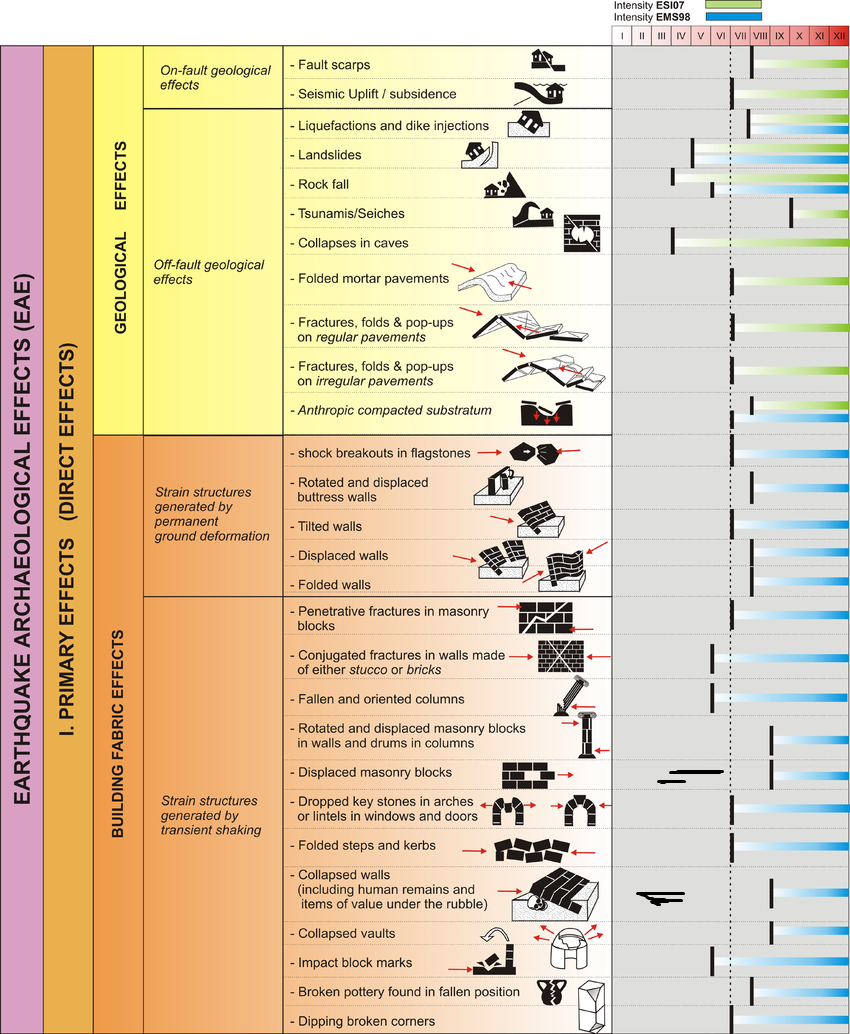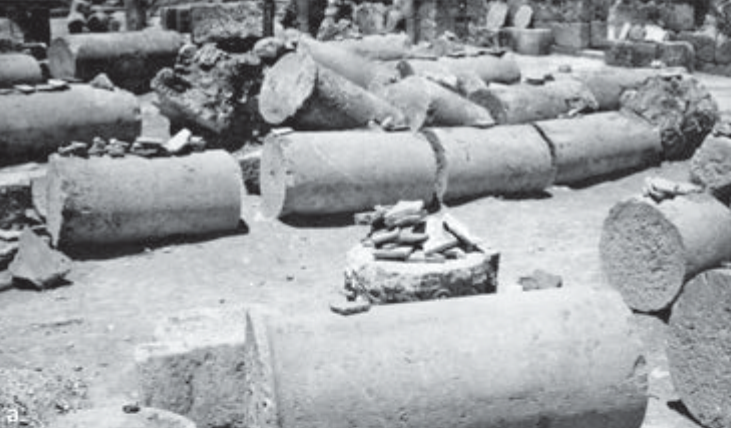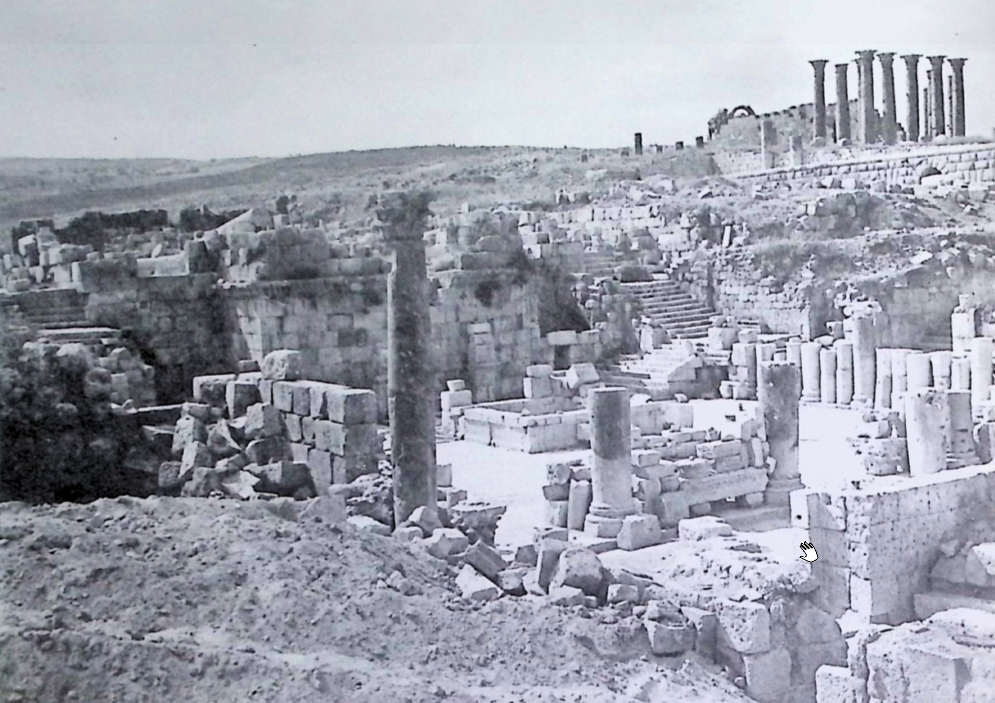Jerash (aka Gerasa) - Church of Saint Theodore
 Church of St. Theodore in Jerash
Church of St. Theodore in Jerash
Archnet - CC BY-NC 4.0
Crowfoot (1929:21) noted that the Church of Saint Theodore was
located on the west bank of the river in the centre of town, close to the Temple of Artemis
suggesting that it was the most important, if not the largest, of the Christian churches in Jerash
. An inscription dated laying of the foundation to the autumn of
494 CE and completion of construction to around 496 CE (Crowfoot, 1929:22). The church was
part of a larger ecclesiastical complex.
- from Chat GPT 4o, 21 June 2025
The church and its attached structures span over 150 meters from west to east, descending from the elevated basilica platform through a fountain court to the city's colonnaded main street. The complex includes multiple chapels, a baptistery, cisterns, and passages designed for liturgical procession, catechumens, and ritual purification.
Its planning reflects a high level of architectural sophistication, adapting to a steep natural slope through terracing and multi-level integration. Features such as the low chancel screen, the centrally placed ambo, and the eastern stairs flanking the apse were likely inspired by prescriptions in the Testamentum Domini, a 5th-century Syrian church order.
Despite signs of later reuse and repair, the church complex was never rebuilt after its violent destruction, attributed to the 749 CE Sabbatical Year Earthquake. Today, the site offers a unique window into late antique urban church design in the eastern Roman provinces.
- from Jerash - Introduction - click link to open new tab
- Fig. 1 - Plan of Ecclesiastical
complex Jerash from Moralee, J. (2006)

 Fig. 1
Fig. 1
Ecclesiastical complex at Gerasa, adapted from Beat Brenk et al., "Neue Forschungen zur Kathedrale von Gerasa: Probleme der Chronologie und der Vorgângerbauten," ZDPV 112 (1996): 139-55, fig. 1.
Moralee (2006) - Fig. 8 - Plan of the Church of
St Theodore from Raja (2025)

 Fig. 8
Fig. 8
Plan of the Church of St Theodore Date: ca. AD 494/496 (dated by Inscription, Michel 2001: 237-238) - ?
Raja (2025)
- Fig. 1 - Plan of Ecclesiastical
acomplex t Jerash from Moralee, J. (2006)

 Fig. 1
Fig. 1
Ecclesiastical complex at Gerasa, adapted from Beat Brenk et al., "Neue Forschungen zur Kathedrale von Gerasa: Probleme der Chronologie und der Vorgângerbauten," ZDPV 112 (1996): 139-55, fig. 1.
Moralee (2006) - Fig. 8 - Plan of the Church of
St Theodore from Raja (2025)

 Fig. 8
Fig. 8
Plan of the Church of St Theodore Date: ca. AD 494/496 (dated by Inscription, Michel 2001: 237-238) - ?
Raja (2025)
- Fig. 3.38a Basilica of St
Theodore's Church during excavation showing the orientation of fallen columns from Boyer (2022)
- Fig. 5.5 The Church of St
Theodore after excavation with the Cathedral in the background from Lichtenberger and Raja (2025)
- Fig. 5.6 The so-called
Fountain Court between the Church of St Theodore and the Cathedral after excavation from Lichtenberger and Raja (2025)
- Fig. 3.38a Basilica of St
Theodore's Church during excavation showing the orientation of fallen columns from Boyer (2022)
- Fig. 5.5 The Church of St
Theodore after excavation with the Cathedral in the background from Lichtenberger and Raja (2025)
- Fig. 5.6 The so-called
Fountain Court between the Church of St Theodore and the Cathedral after excavation from Lichtenberger and Raja (2025)
- from Chat GPT 4o, 21 June 2025
- from Crowfoot in Kraeling (1938:223–260)
| Phase | Period | Date | Description |
|---|---|---|---|
| I | Roman (earlier use) | 2nd–3rd c. CE | Substructures and reused masonry fragments suggest reuse of earlier Roman buildings. Mosaic fragment beneath the apse may date to the 2nd–3rd century CE. |
| II | Byzantine | 494–496 CE | Church of Saint Theodore constructed with extensive use of spolia. Dated by a Greek hexameter inscription on the west end of the church. |
| III | Umayyad | Early 8th c. CE | Evidence of occupation and limited renovation or salvage activity. Rooms south of the atrium show preparation for repairs, with stacked tiles and protective layers over mosaics. |
| IV | Destruction/Abandonment | 749 CE | Complex destroyed by earthquake. All nave columns toppled in situ; walls collapsed; no subsequent rebuilding. Site later occupied by squatters. |
- Site Plan of Jerash
from Wikipedia
- Fig. 1 - Plan of Ecclesiastical
acomplex t Jerash from Moralee, J. (2006)

 Fig. 1
Fig. 1
Ecclesiastical complex at Gerasa, adapted from Beat Brenk et al., "Neue Forschungen zur Kathedrale von Gerasa: Probleme der Chronologie und der Vorgângerbauten," ZDPV 112 (1996): 139-55, fig. 1.
Moralee (2006)
- Site Plan of Jerash
from Wikipedia
- Fig. 1 - Plan of Ecclesiastical
acomplex t Jerash from Moralee, J. (2006)

 Fig. 1
Fig. 1
Ecclesiastical complex at Gerasa, adapted from Beat Brenk et al., "Neue Forschungen zur Kathedrale von Gerasa: Probleme der Chronologie und der Vorgângerbauten," ZDPV 112 (1996): 139-55, fig. 1.
Moralee (2006)
Crowfoot (1929:19) attributed destruction of the Church of Saint
Theodore to a mid 8th century CE earthquake noting that this date fits the latest class of objects which we found upon our floor levels
.
Crowfoot (1929:26) described the collapsed columns as follows:
The columns, fourteen in number, with their Corinthian capitals, were all lying where they had fallen ; not a single capital was missing, not a single drum had been removed, but not a single one was upon its base ; in the west half of the church the columns had fallen inwards, across each other, but in the east half most of them had fallen to the north after the collapse of the side walls, both of which in this part had fallen to the south. Masons' marks on the sections of the column drums showed that these columns had been used previously for the same building as the engaged columns and certain other carved blocks which we found built into the side walls ; the style of the Corinthian capitals suggests that this earlier building may have belonged to the beginning of the third century, and the lettering of the masons' marks appears to belong to the same period.Crowfoot (1938:223-4) in Kraeling (1938) described the archaeoseismic evidence at the Church of St Theodore in Jerash.
It was quite clear from the condition of the basilica and the atrium that both had been destroyed by an earthquake. In the basilica all the columns were lying where they had fallen; not a single capital or drum had been carried away, but the bases only were in position. In the west half the columns fell inwards across each other; in the east half most of them had fallen to the north after the collapse of the side walls ; the apse fell outward into the Fountain Court. The violence of the shock which ruined the place was particularly clear at the entrance to the atrium, where some of the upper blocks seem to have turned a somersault in the air. In two of the side chambers there were signs of preparations to salvage building material. Fallen stones and tiles were found stacked in neat piles, but the place was ultimately abandoned wholly to squatters who converted the rooms and alleys round the atrium into stables for their animals and dwelling places for themselves.Crowfoot (1938:260) in Kraeling (1938) noted that
the west wall of the atrium was built of very massive stones, many of them dangerously dislocated by earthquake shocks.
- from Chat GPT 4o, 21 June 2025
- from Crowfoot (1929)
All fourteen Corinthian columns in the nave were found toppled, none upright or looted. In the west half of the church, they fell inward and crisscrossed one another, while in the east half, they fell northward after the southern side wall collapsed southward. No drums or capitals had been moved, suggesting sudden abandonment after a violent event (Crowfoot, 1929:26).
Bronze-clamped wall facings, sections of the chancel screen, and the ambo remained undisturbed beneath collapsed roofing debris. Roofing tiles and timbers—some preserved—were found above these fixtures, confirming that destruction happened while the fittings were still intact. The atrium doorway collapsed in a manner consistent with seismic shock, and multiple other buildings in the complex show stacked rubble or abandoned architectural salvage in preparation for restoration that never occurred (Crowfoot, 1929:25).
In the baptistery and south rooms, blocked doors, covered mosaics, ash layers, and a concentration of collapsed tiles and marble fragments suggest that the earthquake triggered a termination of planned reconstruction. Burnt materials and neatly stacked architectural elements imply an attempt at repair or preservation prior to the site’s final abandonment.
The Fountain Court below the apse, which predates the church, also reveals signs of significant reworking and damage. Severely displaced paving, blocked water channels, and reused architectural fragments further support regional seismic destruction. Though this zone had earlier origins, its final use phases align with the same mid-8th century terminus as the church above.
- from Chat GPT 4o, 21 June 2025
- from Crowfoot in Kraeling (1938)
All fourteen nave Corinthian columns were found toppled in situ — none removed or reused — with those in the western half of the church fallen inward across each other, and those in the eastern half fallen northward after the side walls collapsed southward. The apse had fallen outward into the adjacent Fountain Court.
At the entrance to the atrium, upper masonry blocks appeared to have “turned a somersault in the air,” highlighting the violence of the seismic shock. In side chambers, tiles and stones had been stacked for reuse, but abandonment followed before restoration could be completed.
The west wall of the atrium, built of massive stone blocks, was “dangerously dislocated by earthquake shocks,” according to the excavators, confirming that the entire complex suffered catastrophic failure during this seismic event.
- from Walmsley (2007)
29 Kraeling (1938) 208, 223, 247–49.
| Effect | Location | Image(s) | Description |
|---|---|---|---|
| Fallen Columns | Basilica
 Fig. 1
Fig. 1Ecclesiastical complex at Gerasa, adapted from Beat Brenk et al., "Neue Forschungen zur Kathedrale von Gerasa: Probleme der Chronologie und der Vorgângerbauten," ZDPV 112 (1996): 139-55, fig. 1. Moralee (2006) |
|
|
| Collapsed walls | side walls of the east half of the Basilica
 Fig. 1
Fig. 1Ecclesiastical complex at Gerasa, adapted from Beat Brenk et al., "Neue Forschungen zur Kathedrale von Gerasa: Probleme der Chronologie und der Vorgângerbauten," ZDPV 112 (1996): 139-55, fig. 1. Moralee (2006) |
|
|
| Vault collapse | Apse
 Fig. 1
Fig. 1Ecclesiastical complex at Gerasa, adapted from Beat Brenk et al., "Neue Forschungen zur Kathedrale von Gerasa: Probleme der Chronologie und der Vorgângerbauten," ZDPV 112 (1996): 139-55, fig. 1. Moralee (2006) |
|
|
| Collapsed walls | Entrance to the Atrium
 Fig. 1
Fig. 1Ecclesiastical complex at Gerasa, adapted from Beat Brenk et al., "Neue Forschungen zur Kathedrale von Gerasa: Probleme der Chronologie und der Vorgângerbauten," ZDPV 112 (1996): 139-55, fig. 1. Moralee (2006) |
|
|
| Displaced Masonry blocks | west wall of the atrium
 Fig. 1
Fig. 1Ecclesiastical complex at Gerasa, adapted from Beat Brenk et al., "Neue Forschungen zur Kathedrale von Gerasa: Probleme der Chronologie und der Vorgângerbauten," ZDPV 112 (1996): 139-55, fig. 1. Moralee (2006) |
|
- Modified by JW from Fig. 1 of Moralee (2006)
- Earthquake Archeological Effects chart
of Rodríguez-Pascua et al (2013: 221-224)

 Earthquake Archeological Effects (EAE)
Earthquake Archeological Effects (EAE)
Rodríguez-Pascua et al (2013: 221-224)
| Effect | Location | Image(s) | Description | Intensity |
|---|---|---|---|---|
| Fallen Columns | Basilica
 Fig. 1
Fig. 1Ecclesiastical complex at Gerasa, adapted from Beat Brenk et al., "Neue Forschungen zur Kathedrale von Gerasa: Probleme der Chronologie und der Vorgângerbauten," ZDPV 112 (1996): 139-55, fig. 1. Moralee (2006) |
|
|
V + |
| Collapsed walls | side walls of the east half of the Basilica
 Fig. 1
Fig. 1Ecclesiastical complex at Gerasa, adapted from Beat Brenk et al., "Neue Forschungen zur Kathedrale von Gerasa: Probleme der Chronologie und der Vorgângerbauten," ZDPV 112 (1996): 139-55, fig. 1. Moralee (2006) |
|
VIII + | |
| Vault collapse | Apse
 Fig. 1
Fig. 1Ecclesiastical complex at Gerasa, adapted from Beat Brenk et al., "Neue Forschungen zur Kathedrale von Gerasa: Probleme der Chronologie und der Vorgângerbauten," ZDPV 112 (1996): 139-55, fig. 1. Moralee (2006) |
|
VIII + | |
| Collapsed walls | Entrance to the Atrium
 Fig. 1
Fig. 1Ecclesiastical complex at Gerasa, adapted from Beat Brenk et al., "Neue Forschungen zur Kathedrale von Gerasa: Probleme der Chronologie und der Vorgângerbauten," ZDPV 112 (1996): 139-55, fig. 1. Moralee (2006) |
|
VIII + | |
| Displaced Masonry blocks | west wall of the atrium
 Fig. 1
Fig. 1Ecclesiastical complex at Gerasa, adapted from Beat Brenk et al., "Neue Forschungen zur Kathedrale von Gerasa: Probleme der Chronologie und der Vorgângerbauten," ZDPV 112 (1996): 139-55, fig. 1. Moralee (2006) |
|
VIII + |
Boyer, D. D. (2022) Water Management in Gerasa and its Hinterland: From the Romans to AD 750
, Brepols Publishers
Crowfoot, J. (1929). "The Church of S. Theodore at Jerash." Palestine exploration quarterly 61(1): 17-36.
Lichtenberger and Raja eds. (2025) Jerash, the Decapolis, and the Earthquake of AD 749, Brepolis
Moralee, J. (2006). "The Stones of St. Theodore: Disfiguring the Pagan Past in Christian Gerasa." Journal of Early Christian Studies 14: 183-215.
Raja, Rubina (2025) Late Antique Churches in Gerasa, Jordan, as Reflections of Urban Heterarchies
, Religion and Urbanity Online
Walmsley, A. (2007). Early Islamic Syria. An archaeological appraisal. London, Bloomsbury Publishing.
Kraeling, C. (1938) Gerasa: City of the Decapolis, American Schools of Oriental Research.
- bookmarked to the start of the section on Christian Churches by Crowfoot - can be borrowed with a free account from archive.org
Kraeling, C. (1938) Gerasa: City of the Decapolis, American Schools of Oriental Research. - open access at Hathi Trust





